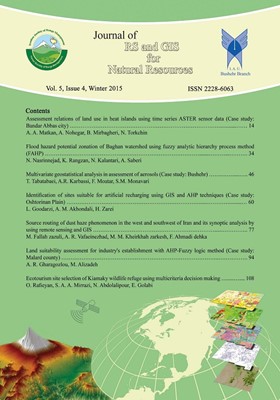Multivariate geostatistical analysis in assessment of aerosols (Case study: Bushehr)
Subject Areas : Geospatial systems development
Tayebeh Tabatabaei
1
,
Abdolreza Karbassi
2
![]() ,
Faramarz Moatar
3
,
Seyed Masoud Monavari
4
,
Faramarz Moatar
3
,
Seyed Masoud Monavari
4
1 - Ph.D. of Environment, College of Environment and Energy, Islamic Azad University Science and Research Branch, Tehran
2 - Assis. Prof. College of Environment and Energy, Islamic Azad University Science and Research Branch, Tehran
3 - Prof. College of Environment and Energy, Islamic Azad University Science and Research Branch, Tehran
4 - Assis. Prof. College of Environment and Energy, Islamic Azad University Science and Research Branch, Tehran
Keywords:
Abstract :
The mean aerosols samples in three periods of ten stations were taken from Bushehr region, to characterize the spatial variability and concentration of As, Cd, Co, Fe, Ni, Pb and V. The geostatistics and geographic information system (GIS) techniques were applied, and the disjunctive kriging was used to map the spatial patterns of the seven heavy metals. Meanwhile, Principal component analysis (PCA) and correlation matrix (CA) were used for the data processing. The results of Nug/Sill ratios for the seven metals showed that spatial dependent is moderate (0.25-0.75), that indicative the effects of natural factors such as parent material and topography. Meanwhile, the disjunctive kriging technique was used to quantify their concentration distribution. Combined with the results of PCA, 7 heavy metals could be divided into 3 factors. D1 was the metals, i.e., As, Co, Ni, Pb, V. Cd was in D2, Fe in D3. This results show the concentrations of 7 heavy metals were mainly controlled by the external factors. These results will contribute to the management of regional environment.


